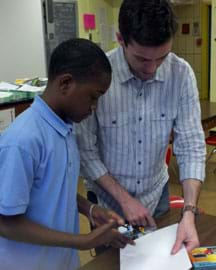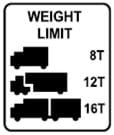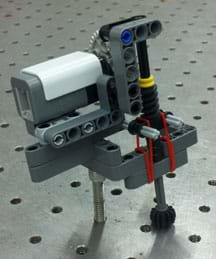Quick Look
Grade Level: 6 (5-7)
Time Required: 45 minutes
Expendable Cost/Group: US $0.00 A non-expendable (and highly reusable) LEGO MINDSTORMS EV3 kit with a force sensor attachment is required for this activity; see the Materials List for details.
Group Size: 3
Activity Dependency: None
Subject Areas: Measurement, Physical Science, Science and Technology

Summary
Students learn first-hand the relationship between force, area and pressure. They use a force sensor built from a LEGO® MINDSTORMS® EV3 kit to measure the force required to break through a paper napkin. An interchangeable top at the end of the force sensor enables testing of different-sized areas upon which to apply pressure. Measuring the force, and knowing the area, students compute the pressure. This leads to a concluding discussion on how these concepts are found and used in engineering and nature.Engineering Connection
Pressure, and the relationship between force, area and pressure, are important engineering concepts in a wide range of engineering disciplines. It is of paramount importance in fluid mechanics, structural analysis, and most other mechanical engineering fields. For example, imagine how necessary it is to understand all aspects of pressure and force when designing dams, roller coasters, bridges, bleachers, prosthetic limbs, submarines and computer keypads.
Learning Objectives
After this activity, students should be able to:
- Describe the relationship between pressure, force and area.
- Distribute a force over an area to make a material withstand more force.
- Explain how the concepts of pressure, force and area apply to engineering and nature.
Educational Standards
Each TeachEngineering lesson or activity is correlated to one or more K-12 science,
technology, engineering or math (STEM) educational standards.
All 100,000+ K-12 STEM standards covered in TeachEngineering are collected, maintained and packaged by the Achievement Standards Network (ASN),
a project of D2L (www.achievementstandards.org).
In the ASN, standards are hierarchically structured: first by source; e.g., by state; within source by type; e.g., science or mathematics;
within type by subtype, then by grade, etc.
Each TeachEngineering lesson or activity is correlated to one or more K-12 science, technology, engineering or math (STEM) educational standards.
All 100,000+ K-12 STEM standards covered in TeachEngineering are collected, maintained and packaged by the Achievement Standards Network (ASN), a project of D2L (www.achievementstandards.org).
In the ASN, standards are hierarchically structured: first by source; e.g., by state; within source by type; e.g., science or mathematics; within type by subtype, then by grade, etc.
NGSS: Next Generation Science Standards - Science
-
Models can be used to represent systems and their interactions.
(Grades 6 - 8)
More Details
Do you agree with this alignment?
-
Analyze displays of data to identify linear and nonlinear relationships.
(Grades 6 - 8)
More Details
Do you agree with this alignment?
-
Develop a model to predict and/or describe phenomena.
(Grades 6 - 8)
More Details
Do you agree with this alignment?
Common Core State Standards - Math
-
Fluently divide multi-digit numbers using the standard algorithm.
(Grade
6)
More Details
Do you agree with this alignment?
International Technology and Engineering Educators Association - Technology
-
Explain how knowledge gained from other content areas affects the development of technological products and systems.
(Grades
6 -
8)
More Details
Do you agree with this alignment?
State Standards
New York - Math
-
Fluently divide multi-digit numbers using the standard algorithm.
(Grade
6)
More Details
Do you agree with this alignment?
New York - Science
-
Develop a model to generate data for iterative testing and modification of a proposed object, tool, or process such that an optimal design can be achieved.
(Grades
6 -
8)
More Details
Do you agree with this alignment?
Materials List
Each student needs:
To share with the entire class:
- LEGO MINDSTORMS EV3 robot, such as EV3 Core Set (5003400) at https://education.lego.com/en-us/products/lego-mindstorms-education-ev3-core-set/5003400#lego-mindstorms-education-ev3
- LEGO force sensor available at https://education.lego.com/en-us/products/lego-technic-force-sensor-by-lego-education/45606
Alternative: LEGO MINDSTORMS NXT Set:
Note: This activity can also be conducted with the older (and no longer sold) LEGO MINDSTORMS NXT set instead of EV3; see below for those supplies:
- LEGO MINDSTORMS NXT robot, such as the NXT Base Set
Worksheets and Attachments
Visit [www.teachengineering.org/activities/view/nyu_measuringp_activity1] to print or download.Pre-Req Knowledge
A familiarity the concepts of force and area. Comfortable with basic math skills, specifically division.
Introduction/Motivation

(Before starting the activity, administer the Pre-Activity Quiz; see the Assessment section for details.)
Engineers often must consider the concept of pressure in their various designs. Have you ever noticed the "floor capacity" signs in a building? Or, have you ever seen "load capacity," "weight limit" or "load limit" signs in elevators or on roadways and bridges? All those numbers are calculated using engineering concepts similar to what you will learn about in today's activity.
Similarly, why does the larger footprint of a snowshoe give an advantage in traversing soft snow? It all has to do with the relationship between area, force and pressure.
Pressure is a fundamental science concept that can be difficult to visualize or conceptualize. The ability to distribute a force over an area to minimize or maximize the pressure exerted is an important skill in engineering. To clarify the obscure aspects of pressure, completing this activity will help you gain a thorough understanding of what pressure is, how it is created, and how to change some variables to increase or decrease pressure.
Procedure
Before the Activity

- Gather materials and make copies of the Pre-Activity Quiz, Pressure Experiment Lab Worksheet and Post-Activity Quiz.
- Construct the LEGO force sensor as shown in Figure 1.
- Calibrate the sensor by placing a mass on it in the vertical upright position, and viewing the displacement. The relation between force and displacement can then be derived. Alternatively, the force sensors can output "LEGO Force," an imaginary unit, without loss of any value to the activity.
With the Students
- Administer the Pre-Activity Quiz.
- Conduct the Introduction/Motivation.
- Divide the class into groups of three students each.
- Hand out a napkin and worksheet to each student.
- Introduce the relationship between force and area (P = F / A), and ask students to hypothesize whether a smaller or a larger area will make it easier to puncture the napkin. Write the hypothesis on the worksheet.
- Demonstrate the procedure with two student volunteers. Have one student hold the napkin and the other read the output of the force sensor while the teacher applies the force to the napkin.
- Instruct the students to repeat the demonstrated procedure in their groups, changing the area on the end of the force sensor for each napkin.
- Record each trial on the worksheet, noting the force that is required to puncture the napkin and the area the force was distributed over.
- Ask students to explain the results they obtained using the equation for pressure.
- Now equipped with experience in relating force, pressure and area, have students apply this knowledge to engineering and physical scenarios. Lead a class discussion on how these concepts are found and used in everyday engineering and nature.
- Using the data collected during the experiment, have students come up with a "maximum loading capacity per unit of area" rating for the napkin, similar to those commonly found in engineered structures such as buildings, elevators, roadways and bridges. What are other engineering examples? (Possible answers: Pressure ratings on pipes and bicycle tires.)
- Why does the wider footprint of a snowshoe provide an advantage in traversing soft snow? (Answer: An equal force spread over a larger area results in a smaller pressure.) Can you name any animals that exploit this relationship? (Answer: The snowshoe hare is a rabbit with very large feet, which put less pressure on a snowy surface, preventing the animal from sinking into the snow as it hops.)
- Why is it easier to pop a balloon with a pin or a needle rather than a blunt object like your finger? (Answer: A pin or needle exerts a much higher pressure due to its smaller area of contact.)
- Why do trucks have wider tires than cars? (Answer: Wider tires distribute the force of the weight of the vehicle across a larger area.)
- Conclude by administering the Post-Activity Quiz.
Vocabulary/Definitions
distributed force: A force that is distributed over an area.
force: An external event that causes change in the motion of a body.
pressure: The force exerted on a surface divided by the area it is exerted over.
Assessment
Pre-Activity Quiz: Before starting the activity, administer the five-question Pre-Activity Quiz to evaluate students' base understanding of the concepts.
Lab Worksheet: During the activity, have students use the Pressure Experiment Lab Worksheet, which provides information, blank data table and questions. Review their answers and calculations to gauge their mastery of the subject matter.
Post-Activity Quiz: After the activity and closing discussion, administer the five-question Post-Activity Quiz to evaluate students' understanding of the concepts.
Additional Multimedia Support
Show students an example of a "CAUTION: Floor load capacity ___ lbs per square foot" load limit sign at Compliance Signs' website: http://safety-signs.compliancesigns.com/signs/Load%20Limit
Show students a humorous elevator capacity sign: "9 persons max, 1000 kg or 1 horse, 5,050 bananas, 6,666 hen eggs, 2,941 pigeons, 88 haddock, 10,526 pound coins" at the March 23, 2012 entry of the Sustainable MBA website at http://www.thesustainablemba.com/2012/03
Subscribe
Get the inside scoop on all things TeachEngineering such as new site features, curriculum updates, video releases, and more by signing up for our newsletter!Copyright
© 2013 by Regents of the University of Colorado; original © 2011 Polytechnic Institute of New York UniversityContributors
Jeffrey LautSupporting Program
AMPS GK-12 Program, Polytechnic Institute of New York UniversityAcknowledgements
This activity was developed under the Applying Mechatronics to Promote Science (AMPS) Program funded by National Science Foundation GK-12 grant no. 0741714. However, these contents do not necessarily represent the policies of the NSF and you should not assume endorsement by the federal government.
Additional support was provided by the Central Brooklyn STEM Initiative (CBSI), funded by six philanthropic organizations.
Last modified: October 16, 2020





User Comments & Tips